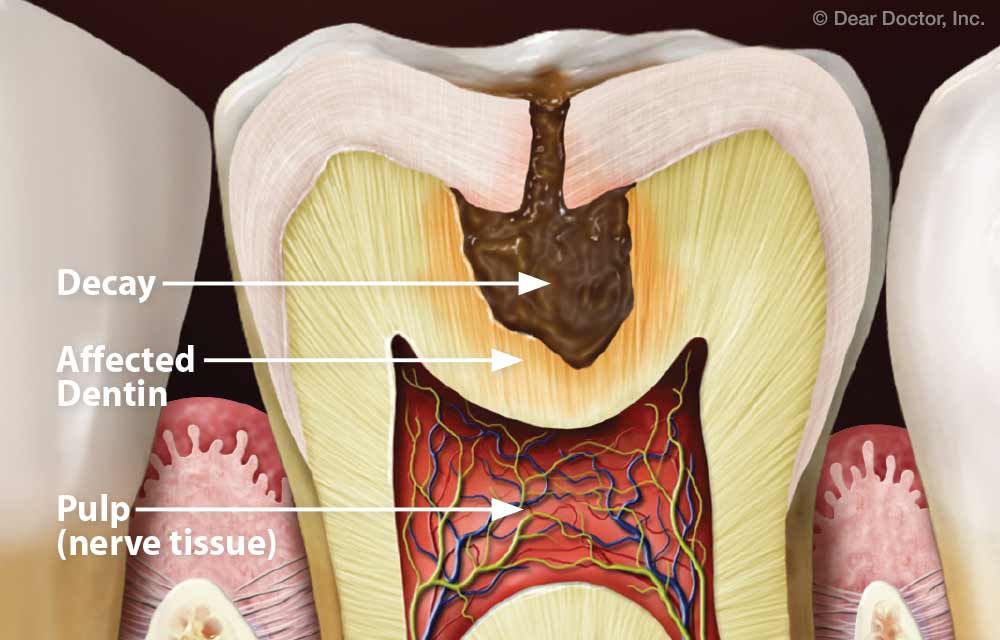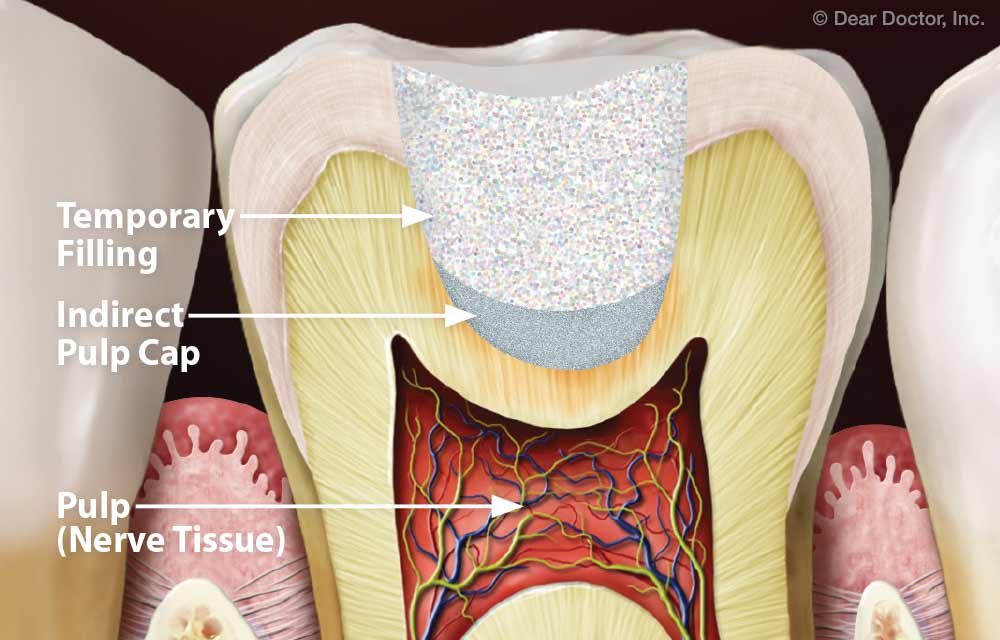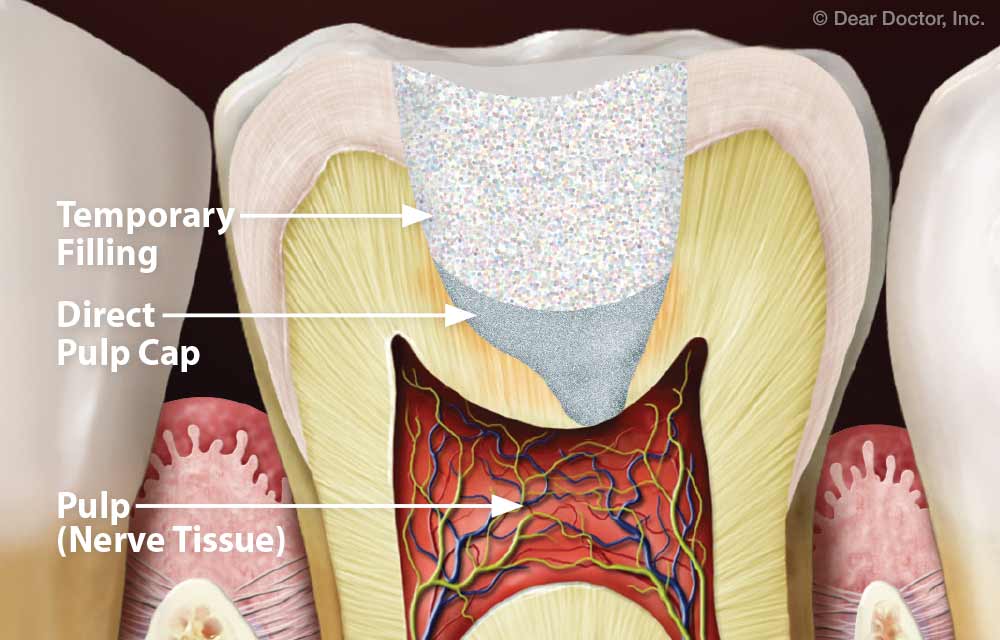Pulp Capping
A Procedure That May Help Save a Decayed Tooth
Dear Doctor,
A friend told me that her deeply decayed tooth was saved with a procedure called “pulp capping”—and she avoided having a root canal! Can you tell me more about this?
Dear Erik,
It’s not surprising that you aren’t familiar with pulp capping. It’s not nearly as common a dental procedure as filling a cavity, or even having a root canal—and it isn’t appropriate in all situations. Yet in some cases, pulp capping may offer a viable alternative to root canal treatment. So let’s take a closer look.
 |
| A large area of decay is progressing very close to the pulp (nerve tissue) of the tooth. If decay bacteria reach the pulp, root canal treatment will be needed. |
 |
| Indirect Pulp Cap — Decay has not yet reached the pulp. Some affected dentin is removed and protective material is applied, leading to healing and remineralization. A temporary filling is then placed on the tooth. |
 |
| Direct Pulp Cap — Pulp tissue has been exposed. After removal of some affected dentin, a biocompatible material is placed directly over the tooth’s pulp. The temporary or a permanent filling is placed. |
Tooth decay is among the most frequent dental problems. When your dentist finds a cavity, the standard treatment involves using a dental instrument to remove the decayed tooth material, and then restoring the tooth with an amalgam (silver) or composite (tooth-colored) filling. But decay sometimes manages to work its way deep inside the tooth. If it proceeds far enough, the bacteria that cause decay may even reach the pulp—the soft tissue at the tooth’s core, which contains nerves and blood vessels.
Once pulp tissue has become infected with bacteria, the only way to save the tooth is via root canal treatment. In this procedure, the pulp is removed from its inner chamber, and the tooth is disinfected, filled and sealed, and restored. Without treatment, the tooth may ultimately need to be extracted, as the infection will not go away on its own, and if left untreated it can spread, causing more serious problems.
But in certain situations, healthy (non-infected) pulp tissue may become exposed, or nearly exposed, even when the decay hasn’t penetrated all the way into the pulp chamber. This could happen, for example, when decayed tooth material must be removed during treatment for a deep cavity. That’s when a pulp capping procedure may be considered.
There are two different types of capping procedures: “direct” and “indirect” pulp capping. It’s important to note that either procedure can be done only if the pulp tissue is healthy and shows no signs of infection, and the patient has no symptoms (such as discomfort or irritation). If inflammation or infection is present or other negative indications are found, root canal treatment will be recommended instead.
When the pulp tissue is actually exposed, a direct pulp capping procedure can be performed. First, the affected tooth is isolated from the rest of the mouth to prevent contamination (usually with a thin, flexible barrier called a dental dam), and the decay is removed. If pulp tissue is exposed, bleeding will occur from the pulp. After the bleeding has been stopped, the tooth is cleaned and dried, and a protective biocompatible material is applied directly over the pulp. This seals it against infection and allows some healing to occur. Finally, a filling or another type of restoration is placed on the tooth, to bring it back to proper function and good appearance.
The indirect pulp capping procedure, which may be done when pulp tissue is close to the surface but not actually exposed, involves two treatments spaced about six to eight months apart. It is sometimes recommended in situations where decay is not yet causing symptoms (such as pain), but has penetrated so deeply into the dentin (inner tooth material) that removing it would almost certainly expose the pulp.
In this procedure, the dentist removes the majority of the decayed tooth material, but leaves a small portion of it in place, covering the pulp tissue. This softened or decayed dentin is treated with a material similar to that used in direct pulp capping. The protective layer that is applied promotes remineralization of the dentin. Next, a temporary filling is placed on the tooth. Months later, this temporary restoration is removed and healing is evaluated. In many cases, the dentin covering the pulp has regenerated, and any residual decay can be safely removed. Finally, the tooth is given a permanent restoration.
The advantages of pulp capping include that it is less invasive and less costly compared to root canal treatment. The disadvantage is that some patients will still require a root canal after the capping procedure has been performed. Patients who are considering the procedure must be aware that despite our best efforts, it may not provide a permanent solution, and root canal treatment could still be needed later. Yet under the right circumstances and conditions, it is reasonable to consider pulp capping as a way to save a tooth.





